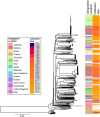Whole Genome Sequencing for Surveillance of Diphtheria in Low Incidence Settings
- PMID: 31497588
- PMCID: PMC6713046
- DOI: 10.3389/fpubh.2019.00235
Whole Genome Sequencing for Surveillance of Diphtheria in Low Incidence Settings
Abstract
Corynebacterium diphtheriae (C. diphtheriae) is a relatively rare pathogen in most Western countries. While toxin producing strains can cause pharyngeal diphtheria with potentially fatal outcomes, the more common presentation is wound infections. The diphtheria toxin is encoded on a prophage and can also be carried by Corynebacterium ulcerans and Corynebacterium pseudotuberculosis. Currently, across Europe, infections are mainly diagnosed in travelers and refugees from regions where diphtheria is more endemic, patients from urban areas with poor hygiene, and intravenous drug users. About half of the cases are non-toxin producing isolates. Rapid identification of the bacterial pathogen and toxin production is a critical element of patient and outbreak management. Beside the immediate clinical management of the patient, public health agencies should be informed of toxigenic C. diphtheriae diagnoses as soon as possible. The collection of case-related epidemiological data from the patient is often challenging due to language barriers and social circumstances. However, information on patient contacts, vaccine status and travel/refugee route, where appropriate, is critical, and should be documented. In addition, isolates should be characterized using high resolution typing, in order to identify transmissions and outbreaks. In recent years, whole genome sequencing (WGS) has become the gold standard of high-resolution typing methods, allowing detailed investigations of pathogen transmissions. De-centralized sequencing strategies with redundancy in sequencing capacities, followed by data exchange may be a valuable future option, especially since WGS becomes more available and portable. In this context, the sharing of sequence data, using public available platforms, is essential. A close interaction between microbiology laboratories, treating physicians, refugee centers, social workers, and public health officials is a key element in successful management of suspected outbreaks. Analyzing bacterial isolates at reference centers may further help to provide more specialized microbiological techniques and to standardize information, but this is also more time consuming during an outbreak. Centralized communication strategies between public health agencies and laboratories helps considerably in establishing and coordinating effective surveillance and infection control. We review the current literature on high-resolution typing of C. diphtheriae and share our own experience with the coordination of a Swiss-German outbreak.
Keywords: Corynebacterium diphtheriae; diphtheria; molecular epidemiology; public health; surveillance; toxin; whole genome sequencing.
Figures


Similar articles
-
Outbreak investigation for toxigenic Corynebacterium diphtheriae wound infections in refugees from Northeast Africa and Syria in Switzerland and Germany by whole genome sequencing.Clin Microbiol Infect. 2016 Dec;22(12):1003.e1-1003.e8. doi: 10.1016/j.cmi.2016.08.010. Epub 2016 Aug 30. Clin Microbiol Infect. 2016. PMID: 27585943
-
The changing epidemiology of diphtheria in the United Kingdom, 2009 to 2017.Euro Surveill. 2020 Mar;25(11):1900462. doi: 10.2807/1560-7917.ES.2020.25.11.1900462. Euro Surveill. 2020. PMID: 32209165 Free PMC article.
-
Pastern dermatitis outbreak associated with toxigenic and non-toxigenic Corynebacterium diphtheriae and non-toxigenic Corynebacterium ulcerans at a horse stable in Finland, 2021.Zoonoses Public Health. 2024 Mar;71(2):127-135. doi: 10.1111/zph.13090. Epub 2023 Nov 5. Zoonoses Public Health. 2024. PMID: 37926867
-
Diphtheria.Nat Rev Dis Primers. 2019 Dec 5;5(1):81. doi: 10.1038/s41572-019-0131-y. Nat Rev Dis Primers. 2019. PMID: 31804499 Review.
-
Corynebacterium diphtheriae: genome diversity, population structure and genotyping perspectives.Infect Genet Evol. 2009 Jan;9(1):1-15. doi: 10.1016/j.meegid.2008.09.011. Epub 2008 Oct 19. Infect Genet Evol. 2009. PMID: 19007916 Review.
Cited by
-
Taxonomic classification of strain PO100/5 shows a broader geographic distribution and genetic markers of the recently described Corynebacterium silvaticum.PLoS One. 2020 Dec 21;15(12):e0244210. doi: 10.1371/journal.pone.0244210. eCollection 2020. PLoS One. 2020. PMID: 33347470 Free PMC article.
-
A whole-genome worldwide molecular epidemiology approach for contagious caprine pleuropneumonia.Heliyon. 2020 Oct 8;6(10):e05146. doi: 10.1016/j.heliyon.2020.e05146. eCollection 2020 Oct. Heliyon. 2020. PMID: 33083610 Free PMC article.
-
Genomic characterization of cocirculating Corynebacterium diphtheriae and non-diphtheritic Corynebacterium species among forcibly displaced Myanmar nationals, 2017-2019.Microb Genom. 2023 Sep;9(9):001085. doi: 10.1099/mgen.0.001085. Microb Genom. 2023. PMID: 37712831 Free PMC article.
-
Population genomics and antimicrobial resistance in Corynebacterium diphtheriae.Genome Med. 2020 Nov 27;12(1):107. doi: 10.1186/s13073-020-00805-7. Genome Med. 2020. PMID: 33246485 Free PMC article.
-
Cluster of Nontoxigenic Corynebacterium diphtheriae Infective Endocarditis and Rising Background C. diphtheriae Cases-Seattle, Washington, 2020-2023.Clin Infect Dis. 2024 May 15;78(5):1214-1221. doi: 10.1093/cid/ciae094. Clin Infect Dis. 2024. PMID: 38381586 Free PMC article.
References
-
- Liu C, Guo J. Hypervirulent Klebsiella pneumoniae (hypermucoviscous and aerobactin positive) infection over 6 years in the elderly in China: antimicrobial resistance patterns, molecular epidemiology and risk factor. Ann Clin Microbiol Antimicrob. (2019) 18:4. 10.1186/s12941-018-0302-9 - DOI - PMC - PubMed
-
- Acevedo R, Bai X, Borrow R, Caugant DA, Carlos J, Ceyhan M, et al. . The global meningococcal initiative meeting on prevention of meningococcal disease worldwide: epidemiology, surveillance, hypervirulent strains, antibiotic resistance and high-risk populations. Exp Rev Vaccines. (2019) 18:15–30. 10.1080/14760584.2019.1557520 - DOI - PubMed
Publication types
LinkOut - more resources
Full Text Sources

